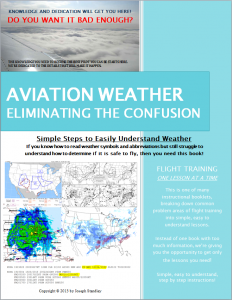Safe Weather Decision Making
You have faa.gov weather publications and can find weather charts on aviationweather.gov but do you understand aviation weather good enough to make safe, “go/no go” decisions as a pilot? General aviation pilots preflight weather planning and decision making is important to your safety.
Aviation Symbols and Abbreviations
The first step to learning weather is to learn to read the weather charts. There are many abbreviations and symbols on aviation weather charts and if you don’t know what they say, then how can you analyze the weather properly? Learning aviation symbols and abbreviations takes time but it must be done. There are many FAA weather publications out there as well as private publications addressing weather symbols, abbreviations and charts. You won’t remember every single one, especially the ones you will never use or see such as dust storm if you live in the Midwest, but you should know quite a bit.
The Problem With Weather Information
Once you have a good knowledge of aviation weather symbols and abbreviations you will be able to look at the charts on aviationweather.gov or other weather sites and know what information is on them. Knowing what information is on them and knowing what they mean or how it affects you is different. The problem is that most aviation weather books out there are all the same. They explain things very technical, boring and hard to understand. That’s great for passing a written test with boring technical questions that need an answer, but it would be nice to know what it means in real life.
Learn to Anticipate Weather
In order to make good weather decisions as a pilot, you have to know how things can affect you. You have to be able to anticipate what will happen and know whether a weather forecast could change or how reliable it is. Do you cancel, just because there is an airmet for possible thunderstorms or snow in the area? Do you fly if it’s marginal VFR? You have to know the legal limits of whether you can fly to help in your decision making but just knowing the limits isn’t good enough. If the ceiling is 2000′, are you legal to fly? You may think to yourself “I can fly as long as I’m 500′ below the clouds and I have 3 miles visibility because I’m in class E airspace”. That’s great, you know the legal limit, but is it ok to do? Can it be done safely? Should you attempt it or cancel? Most publications don’t talk to you about this.
Options to Learn to Make Safe Go/No Go Decisions
It takes years of experience, comparing actual flight conditions with the weather forecasts and hands on experience to start getting real comfortable with it but there are ways you can get a head start. You can pay an instructor $30-$50 an hour to walk you through detailed steps of analyzing weather. Start reading weather charts and forecasts and comparing actual weather to forecast weather to see how accurate it is. You should know the risks and how they affect you. These are all good ways to start. Your instructor can help you with this but there are many people out there that can’t afford to pay an instructor for more hours of training so they choose to study at home to save the money. I’m all for home study as long as you are dedicated and the material is easy enough for you to understand.
An Easy Way to Learn Aviation Weather Decision Making
I know there isn’t much out there to choose from for real life thought processes to help you in your aviation weather decision making and I see students struggle with it all the time so I have written and e-book explaining things with easy to understand, simple steps to understanding how to make weather decisions. You will learn all about different types of weather and what it means to you in real life terms. You will learn what weather is dangerous and why. Do those icing airmets or snow showers affect you and if so, how? You will learn that too. It’s written in a format to help avoid all the confusion and take out all the technical terms. You still have to know what information the chart is showing you by learning the symbols and abbreviations but the rest will become very clear if you read this e-lesson. I haven’t seen anything like it and I’m sure it will really help you to understand, make safe decisions and to feel more confident in your choices. For the price of less than 30 minutes of instructor time this is a perfect solution to learning how you really need to think to make safe weather decisions.
Only $14.95

Eliminate confusion with simple steps to easily understand aviation weather
I hope you enjoy it as much as I enjoyed making it for you. I’d love to hear how it has helped you, please let me know.
Take Care and Fly Safe!

